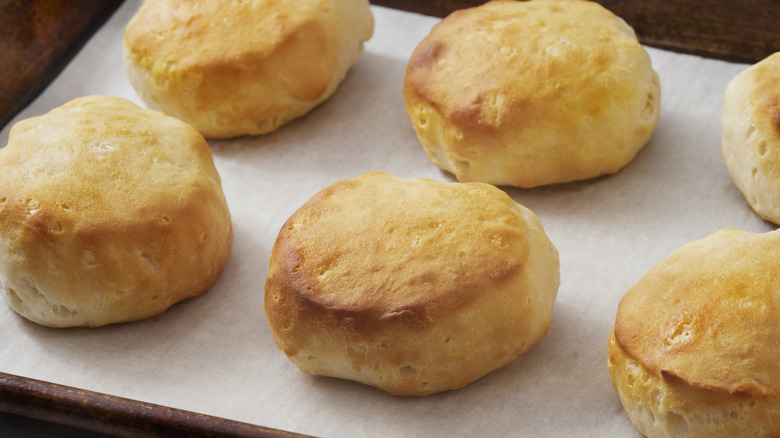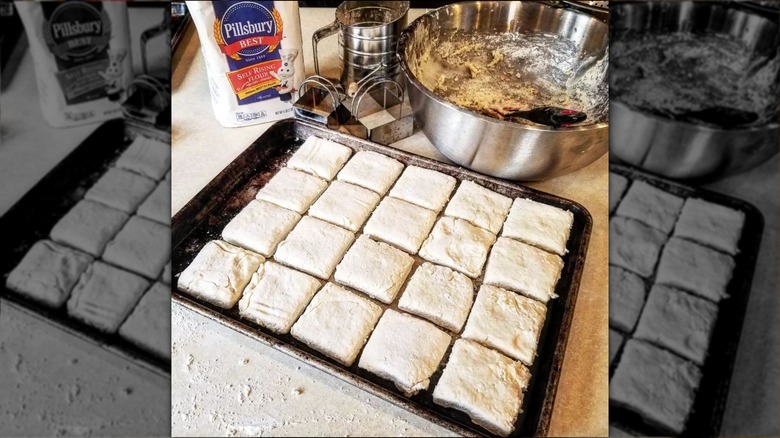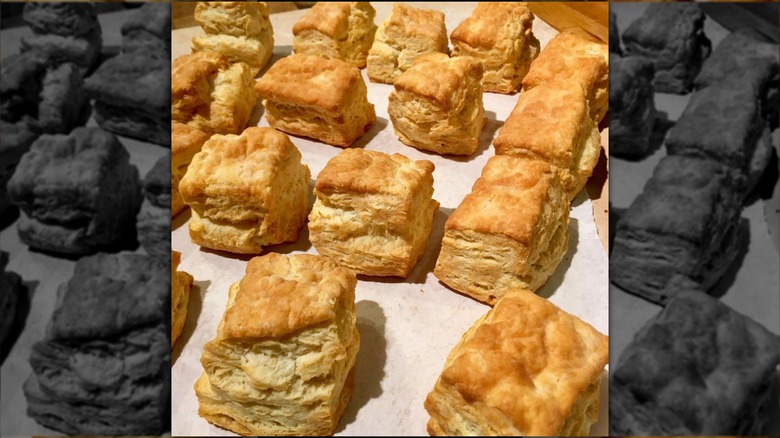The Downside To Using Biscuit Cutters The 'Right Way'
There is a fine art to making any pastry. The dough can be fickle, and if you work it too much, you can ruin the final product. For biscuits, in particular, overworking the dough is a major (but often made) mistake. For these pastries, it's important to keep the dough cold, which helps your biscuits turn out nice and flaky. The more time you roll it out and handle it, the dough will warm up and become overworked, leading to flat, tough biscuits. The best way to avoid this is to roll out your biscuit dough only once.
If you're going to use a traditional round biscuit cutter, this creates a problem. You'll either need to waste the excess dough, or you'll need to gather the excess and reroll it to cut again, which risks overworking and warming up your dough. Thankfully, there's a simple solution: instead of a round biscuit cutter, use a bench scraper, knife, or square cutter to cut your biscuits. Of course, this will result in square rather than round biscuits, but it means you only have to roll out your dough once.
Cold dough is key
Cold butter is the key to light, flaky biscuits. When butter is cold, it's solid and holds its shape. As you fold grated butter into your biscuit recipe, those solid chunks of butter create pockets of separation in the dough. Once the biscuits hit the oven and the butter starts to melt, water evaporates from the butter, which produces little pockets of air in your pastry that create the flakiness you expect out of a biscuit. If your butter gets too warm as you prepare your biscuits, it will simply melt and incorporate into the dough.
The more you mix and work with your dough, the more the butter will warm up due to the heat of your hands and the temperature of your kitchen. That's why only rolling out your dough once can help; your dough will be exposed to less of the heat in your kitchen as well as your body heat.
If you're afraid your dough is getting too warm, you can pop it into the refrigerator before you continue to mix and roll it out. Then, use a knife, bench scraper, or even a square biscuit cutter to cut your biscuits into shape and get them right into the oven.
Avoiding over developed gluten
But heat isn't the only problem you'll face if you opt for round biscuit cutters and roll out your dough multiple times. Biscuit cutters also cause you to overwork your dough as well.
Overworked dough is really the result of gluten activation. Whenever you add water to flour, strings of gluten are formed, giving your bread and pastries structure and texture. Gluten is also formed whenever you handle your dough whether that's kneading, mixing, rolling, or any other number of other baking tasks. Gluten activation is essential for baked goods to give them texture and to help the dough hold together. When it comes to biscuits though, if too much gluten develops you'll end up with a tough biscuit that has a texture more like bread so you don't want to over-activate the gluten by handling and rolling the dough too much. Cutting square biscuits is the simple solution that uses every inch of dough on the first roll — no overworked dough and no wastage.
If you start making square biscuits, you might notice that the round biscuits you made in the past baked more evenly. In particular, the corners on square biscuits might get a bit more brown than the middle of the biscuit, so that's something to keep an eye on while they're baking. It's a small adjustment to make for biscuits with a light and flaky texture.


